



Introduction
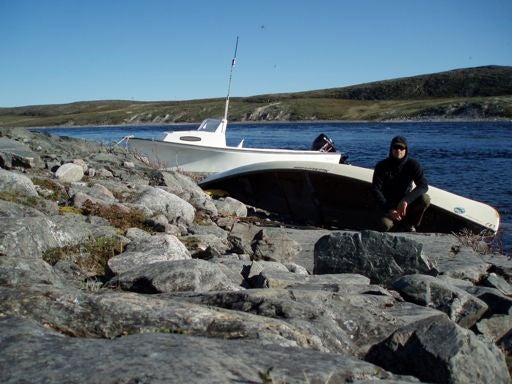
Bryan Grimwood visited Qamani’tuaq from May 4 – 19, 2010. This was Bryan’s third visit to the community. His previous visits occurred in July 2008 and October/November 2009. The purpose of Bryan’s visit in May was to begin community-based research activities. These activities are important components of Bryan’s PhD study about the Thelon River. The Nunavut Research Institute licensed this project in February 2010 (License # 03 026 10N-M). The project involves working with Qamani’tuaq residents and Thelon River tourists to document and create knowledge about the Thelon River using photographs, and to use these photographs to share knowledge about responsibility within the Thelon River watershed. This is important because the Thelon is a special place for Inuit and Qallunaat, and for many different reasons. The river is also a changing place. For example: the population of caribou and other country food sources along the river fluctuate; resource development initiatives, such as gold and uranium mining, create new social and environmental challenges and opportunities; river water levels are observed to be decreasing; although technological advances make river travel more accessible, the increasing cost of taking these journeys inhibits many people.
Before the May 2010 visit, Bryan had communicated with 21 Qallunaat who had travelled the river by canoe in previous summer seasons. These people contributed approximately 300 photographs from the Thelon, some of which were taken as long ago as 1967! Many photographs were from river sections in the Northwest Territories, while many others were from within Nunavut.
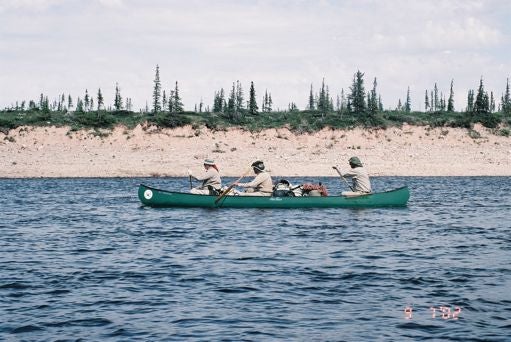
Objectives of community visit No. 3
There were three objectives for Bryan’s visit in May:
- To continue building research relationships within the community;
- To initiate ‘data collection’;
- To plan and prepare the next stages of the project.
Building research relationships
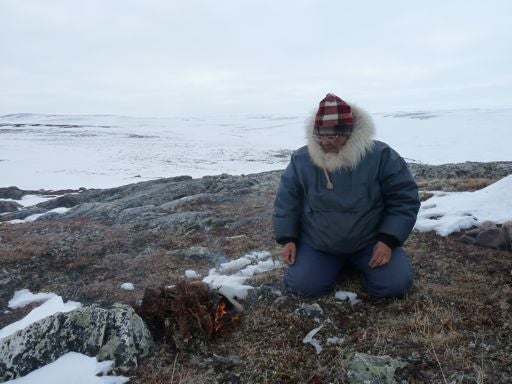
Bryan has been fortunate to observe and participate in effective research relationships between other Nunavut communities and university researchers. In Qamani’tuaq, Bryan is trying to follow these models and to build similar partnerships with the hope that a safe space might be created for sharing knowledge and diverse perspectives about the Thelon River. Bryan anticipates that Qamani’tuaq residents, tourists, and researchers can learn from one another, and share in the celebration of and caring for this special place. Of course, this process requires trusting relationships that develop over time.
During the visit, Bryan spoke with community and regional representatives at the Hamlet Office, Hunters and Trappers Organization (HTO), Kivalliq Inuit Association (KIA) office, the Arctic College, and Itsarnitaqarvik Inuit Heritage Centre. Many individuals working at these places provided helpful suggestions, thoughtful ideas, instructive feedback, and comfortable meeting spaces. These contributions helped Bryan clarify further the project goals, and complemented the letters of support provided by many of these groups months earlier.
Two community members, Vera Avaala and Kiah Hachey, have agreed to be part of the research team by taking on community research assistant roles. Both Vera and Kiah are involved with the communication of project goals to Qamani’tuaq residents, identifying potential participants and inviting their contributions, and distributing and collecting research materials and information. These connections are important starts to developing long term and mutually beneficial research relationships.
Initiating data collection
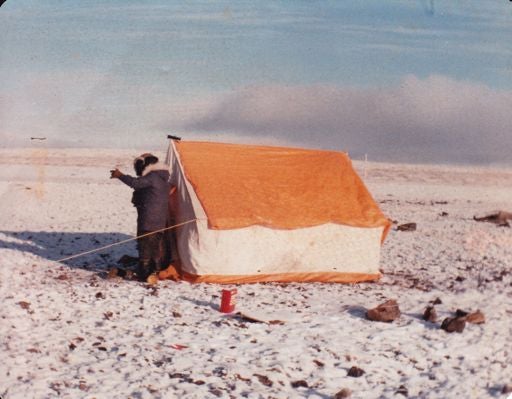
In May, Bryan began the data collection phase of the project in Qamani’tuaq. He carried out a series of photographic interviews and participated in an experiential river journey (but that was actually on the land).
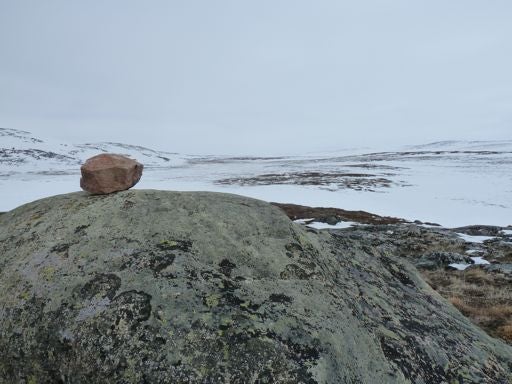
On Saturday, May 8, Vera Avaala guided Bryan on a snow machine and qammutik journey to Halfway Hills. Both Vera and Bryan took photographs to document the journey. Bryan also used an audio voice recorder to make ‘notes’ and a GPS to record the travel route. While having lunch at the base of Half Hills Vera pointed out to Bryan two examples where Inuit had placed small rocks upon larger 3 boulders that pointed to good fishing or hunting locations. This intrigued Bryan because it is a subtle suggestion of ways in which Inuit might view the land; that is, as a place providing people with sustenance and livelihoods. In contrast, the majority of Thelon River tourists try very hard to hide the presence of people (including their own) by covering up their ‘traces’.
Planning and preparing the next stages
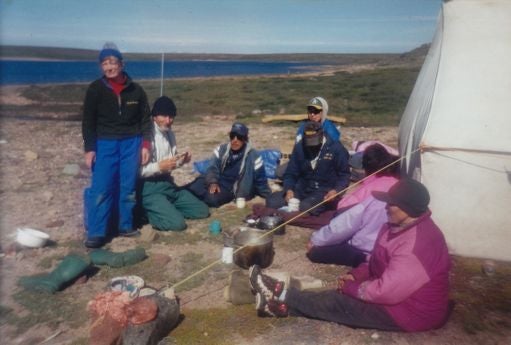
Research activities will continue throughout 2010 and the analysis of materials collected will occur over the next year. Research findings will be reported in Qamani’tuaq in the summer of 2011. During Bryan’s visit, it was important to speak with community representatives about upcoming research activities so that the community is informed about the research process and their input can be integrated. Research assistants, Kiah Hachey and Vera Avaala, have been helpful in this regard. So have the staff at the Itsarnitaqarvik Inuit Heritage Centre, the teacher training students at the Arctic College, and the KIA community liaison representative. Future community-based activities are planned for July 2010 and November 2010. In July, Bryan will be travelling with canoeists along a section of the Thelon River and documenting the journey with photographs, field notes, and GPS. Following this canoe trip, he will be returning to Qamani’tuaq from July 23 – August 1, 2010, during which more photographic interviews will be carried out. Bryan also plans to participate in river journeys by motorboat and Honda/ATV, and facilitate one community workshop. The dates of the November visit to Qamani’tuaq have not been confirmed. However, activities will involve two or three community workshops in which the photographs collected over the course of the project will be displayed and discussed. Participants at these workshops will be invited to share their own stories, ideas, and experiences related to the Thelon River, and that are triggered by the displayed photographs.
Acknowledgements
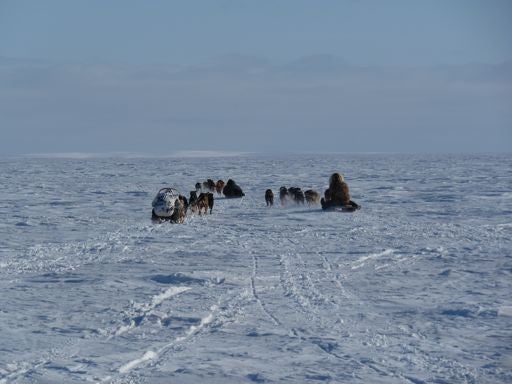
Bryan was fortunate to visit Qamani’tuaq during the annual Hamlet Days celebration. Sincere thanks are extended to all those residents who helped Bryan feel welcome, whether that was during the jigging contest, playing games on the lake, or chatting in the arena. Special thanks to Thomas Qaqimat, Joedee Joedee, Vivian Joedee, Alexander and Patsy Attungala, John Avaala, Ray Didham, David Ford, Kiah Hachey, Gabriel Joedee, Ivik Lund, Susan MacIssac, Tammy Mansbridge, Andy Parker, Valerie Pudnak, Elizabeth Quinangnaq, Robert Seeteenak, and those residents who prefer to remain unidentified. Vera Avaala has been exceptionally generous with assistance, skill, and knowledge contributions. The Social Science and Humanities Research Council, Carleton University, and First Air provided financial support for the May 2010 visit. The trusting support of Bryan’s research supervisor, Dr. Nancy Doubleday, and the guidance provided by Dr. Gita Laidler and other committee members, never goes unnoticed. This report was prepared by Bryan Grimwood. Some photographs were contributed by Vera Avaala, Joedee Joedee, and Jim Fischer.